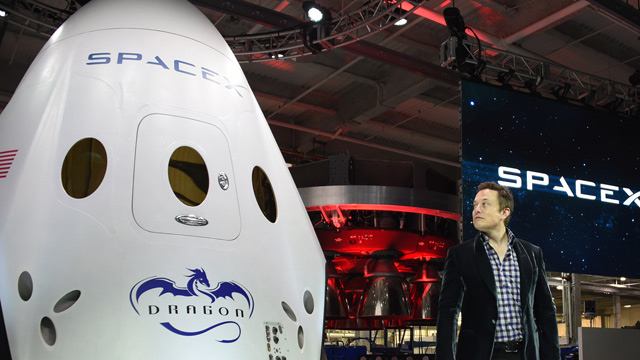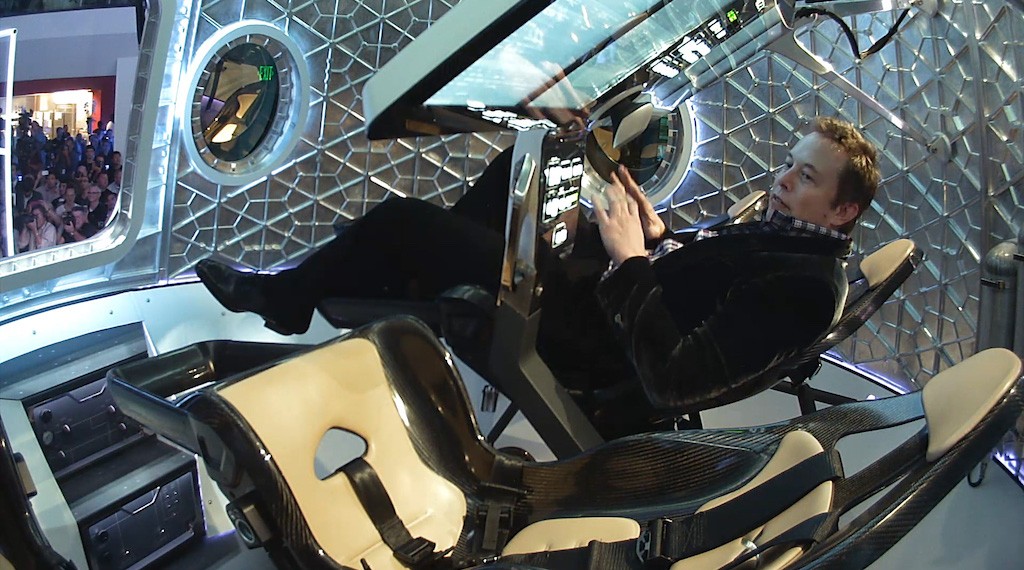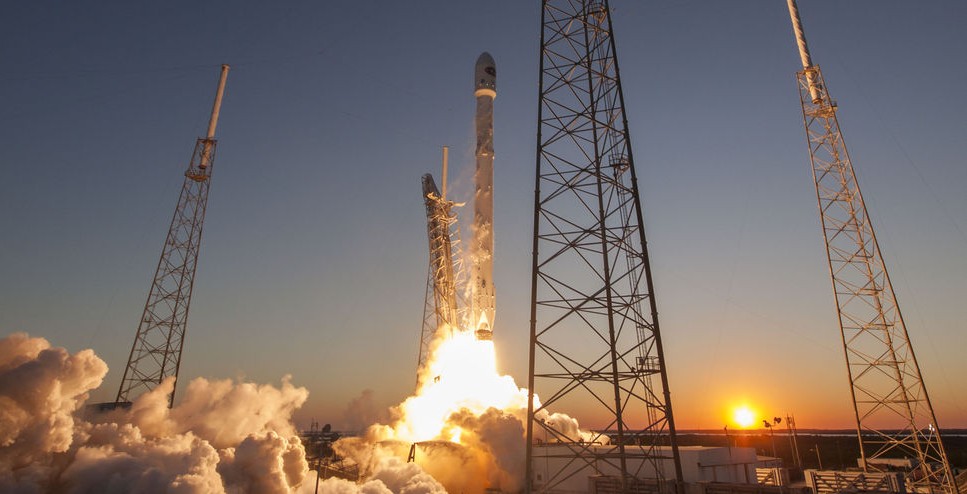

News
Of Mice And Musk: A SpaceX Odyssey
Elon Musk has dreamed of a human colony on Mars since he was a young man. Today, his SpaceX company is taking the first steps toward achieving that dream.
As Ashlee Vance tells it, one wall of Elon Musk’s office at SpaceX headquarters in Hawthorne, California, contains two posters of Mars. On the left is Mars as it exists today – a frozen, lifeless orb. On the right is Musk’s vision of Mars as it could be — a happy place inhabited by humans who frolic on verdant continents surrounded by oceans.
“I would like to die thinking that humanity has a bright future,” he tells Vance while eating cookies and cream with sprinkles on top. “If we can solve sustainable energy and be well on our way to becoming a multi-planetary species with a self-sustaining civilization on another planet—to cope with a worst-case scenario happening and extinguishing human consciousness— then I think that would be really good.” No one has ever accused Elon Musk of thinking too small.
At the turn of the 21st century, Musk had two Martian fantasies. One was to send a colony of mice to the Red Planet and bring them back again, along with their interplanetary babies. The other involved building a greenhouse on Mars and letting Earthlings see the plants inside grow over the internet. Each venture required at least one if not two rocket ships.
He and a coterie of friends traveled twice to Moscow, once in 2001 and again in 2002, trying to purchase surplus Russian rockets that could be refurbished for the Martian missions. The first time did not go well. Recalls Jim Cantrell, one of the team that traveled to Moscow with Musk, “One of their chief designers spit on me and Elon because he thought we were full of shit.” On the second excursion, Musk became convinced the Russians he was meeting with were only interested in fleecing a gullible American with too much money and too few brains.
On the way home from the second failed mission, Musk astonished his team by announcing, “Hey, guys, I think we can build this rocket ourselves.” In June 2002, Space Exploration Technologies, popularly known as SpaceX, was formed to build a cheaper rocket that could carry small payloads into space for paying clients on an average of once a month. The only problem? It had no rocket.
Such trifles were never matters to hold Elon Musk back. He assembled a team of committed rocket engineers and set about accomplishing, with millions, what NASA spent billions doing. Musk’s principle talent, apart from concocting outrageously impossible dreams, is finding people to work for him who are ready, willing and eager to give up all semblance of a normal life in exchange for insane working hours in remote locations. One test launching area was set up in the middle of Texas and another on far away Kwajalein Island, the largest island in an atoll between Guam and Hawaii that is part of the Marshall Islands.
“I would like to die thinking that humanity has a bright future”
SpaceX CEO, Elon Musk
Musk is not a man without a sense of humor. He dubbed his new rocket Falcon 1, paying homage to the Millennium Falcon of Star Wars fame. On its first flight on March 24, 2006, it crashed back to Earth after only 25 seconds. SpaceX employees dutifully donned scuba gear to retrieve some of the pieces from the ocean and set about rebuilding for another attempt.
Musk responded by hiring more engineers and starting work on a brand new rocket, the Falcon 9, that featured one large central rocket surrounded by 8 smaller rockets. Despite the failure of Falcon 1, Musk was already busy positioning the company to bid on NASA contracts to resupply the International Space Station.
On September 1, 2008, Falcon 1 flew its first successful mission. SpaceX was a viable commercial company at last but one that was rapidly going broke. At the end of 2008, Musk knew he would have to choose between SpaceX and Tesla. Alone, one of them might survive. Together? The odds were, both would fail. Musk worried that Tesla would be bought out by one of the Big Three automakers and become just a small part of a giant company.
Later in 2008, Tesla was within hours of defaulting on its payroll obligations. If that happened, Musk’s personal fortune would be gone, along with Tesla and SpaceX. He asked for help from venture capital group VantagePoint but was rebuffed. That’s when Musk put all his chips on red and let them ride.
With all of his dreams and aspirations on the line, Musk executed a colossal bluff. He told investors he would put in $40,000,000 of his own fortune to keep the business going — $40,000,000 he didn’t have. Based on his assurances, other investors agreed to put up $20,000,000 more in financing and the crisis passed. A few weeks later, NASA awarded SpaceX a $1.6 billion contract to do twleve ISS re-supply missions.
Antonio Gracias, a Tesla and SpaceX investor and one of Musk’s closest friends, watched all of this at close hand. He says 2008 told him everything he would ever need to know about Musk’s character. “He has the ability to work harder and endure more stress than anyone I’ve ever met,” Gracias says. “What he went through in 2008 would have broken anyone else. Most people who are under that sort of pressure fray. Their decisions go bad. Elon gets hyperrational. He’s still able to make very clear, long-term decisions. The harder it gets, the better he gets.”
Today, SpaceX launches an average of one rocket a month, carrying payloads for many companies and several nations. Its prices undercut those of Boeing, Lockheed Martin, and Orbital Science by a wide margin. Many of its competitors rely on Russian and other foreign suppliers but SpaceX makes its machines from scratch in the U.S.
Its clientele includes Canadian, European, and Asian customers and it has more than 50 flights planned over the coming years worth more than $5 billion. The company remains privately owned, with Musk as the largest shareholder. SpaceX is profitable and is estimated to be worth $12 billion.
The Falcon 9 has gone from a fantasy to SpaceX’s workhorse. Painted pure white with only an American flag and the SpaceX logo adorning its sides, there’s nothing particularly flashy looking about the Falcon 9. It’s just an elegant, purposeful machine. And to think that for a period of weeks just a few years ago, it’s ability to lead mankind into the dawn of commercial space travel almost died before it was ever born, thanks to a bluff so bold and so daring, it would leave most of us breathless.
Jimmy Buffett once sang, “Read dozens of books about heroes and crooks, and I learned much from both of their styles.” Which one is Elon Musk? Read Ashlee Vance’s book and make up your own mind.
Source: Bloomberg

News
Waymo scrutinized after self-driving taxis cause traffic jams during SF blackout
It’s not farfetched to speculate that it would have been a doomsday scenario for Tesla had FSD behaved this way.

A power outage across San Francisco over the weekend forced numerous Waymo self-driving taxis to stop at darkened intersections and cause traffic blockages in multiple locations across the city. The disruption left riders stranded, frustrated drivers blocked, and city officials stepping in as the Alphabet-owned company temporarily suspended service amid the widespread gridlock.
Needless to say, it would likely have been a doomsday scenario for Tesla had FSD behaved in a similar way, especially if fleets of its robotaxis blocked traffic for numerous drivers.
Power outage halts Waymo fleet
The outage knocked out electricity for tens of thousands of customers, leaving traffic signals dark across large parts of the city, as noted in a report from the New York Times. Waymo vehicles began stopping at intersections and remained stationary for extended periods, seemingly unable to operate. Tow truck operators worked through the night removing immobilized vehicles, while videos circulated online showing Waymos with hazard lights flashing as traffic backed up around them.
Waymo later confirmed that it had paused its Bay Area ride-hailing service after the San Francisco mayor’s office contacted the company about the congestion its vehicles were contributing to. Service began coming back online shortly after 3:30 p.m. local time, though some users still reported being unable to request rides. Waymo maintained that no injuries or accidents were reported during the outage.
Autonomous cars during emergencies
The incident surprised industry observers since autonomous vehicles are designed to function during signal outages and temporary connectivity losses. Waymo stated that its vehicles treat nonfunctional signals as four-way stops, but “the sheer scale of the outage led to instances where vehicles remained stationary longer than usual to confirm the state of the affected intersections. This contributed to traffic friction during the height of the congestion.” Experts suggested the problem may have been linked to the vehicles’ reliance on remote assistance teams, which help resolve complex situations the cars cannot handle independently.
“Yesterday’s power outage was a widespread event that caused gridlock across San Francisco, with non-functioning traffic signals and transit disruptions. While the failure of the utility infrastructure was significant, we are committed to ensuring our technology adjusts to traffic flow during such events,” the Waymo spokesperson stated, adding that it is “focused on rapidly integrating the lessons learned from this event, and are committed to earning and maintaining the trust of the communities we serve every day.”
News
Tesla aims to combat common Full Self-Driving problem with new patent
Tesla writes in the patent that its autonomous and semi-autonomous vehicles are heavily reliant on camera systems to navigate and interact with their environment.

Tesla is aiming to combat a common Full Self-Driving problem with a new patent.
One issue with Tesla’s vision-based approach is that sunlight glare can become a troublesome element of everyday travel. Full Self-Driving is certainly an amazing technology, but there are still things Tesla is aiming to figure out with its development.
Unfortunately, it is extremely difficult to get around this issue, and even humans need ways to combat it when they’re driving, as we commonly use sunglasses or sun visors to give us better visibility.
Cameras obviously do not have these ways to fight sunglare, but a new patent Tesla recently had published aims to fight this through a “glare shield.”
Tesla writes in the patent that its autonomous and semi-autonomous vehicles are heavily reliant on camera systems to navigate and interact with their environment.

The ability to see surroundings is crucial for accurate performance, and glare is one element of interference that has yet to be confronted.
Tesla described the patent, which will utilize “a textured surface composed of an array of micro-cones, or cone-shaped formations, which serve to scatter incident light in various directions, thereby reducing glare and improving camera vision.”

The patent was first spotted by Not a Tesla App.
The design of the micro-cones is the first element of the puzzle to fight the excess glare. The patent says they are “optimized in size, angle, and orientation to minimize Total Hemispherical Reflectance (THR) and reflection penalty, enhancing the camera’s ability to accurately interpret visual data.”
Additionally, there is an electromechanical system for dynamic orientation adjustment, which will allow the micro-cones to move based on the angle of external light sources.
This is not the only thing Tesla is mulling to resolve issues with sunlight glare, as it has also worked on two other ways to combat the problem. One thing the company has discussed is a direct photon count.
CEO Elon Musk said during the Q2 Earnings Call:
“We use an approach which is direct photon count. When you see a processed image, so the image that goes from the sort of photon counter — the silicon photon counter — that then goes through a digital signal processor or image signal processor, that’s normally what happens. And then the image that you see looks all washed out, because if you point the camera at the sun, the post-processing of the photon counting washes things out.”
Future Hardware iterations, like Hardware 5 and Hardware 6, could also integrate better solutions for the sunglare issue, such as neutral density filters or heated lenses, aiming to solve glare more effectively.
Elon Musk
Delaware Supreme Court reinstates Elon Musk’s 2018 Tesla CEO pay package
The unanimous decision criticized the prior total rescission as “improper and inequitable,” arguing that it left Musk uncompensated for six years of transformative leadership at Tesla.

The Delaware Supreme Court has overturned a lower court ruling, reinstating Elon Musk’s 2018 compensation package originally valued at $56 billion but now worth approximately $139 billion due to Tesla’s soaring stock price.
The unanimous decision criticized the prior total rescission as “improper and inequitable,” arguing that it left Musk uncompensated for six years of transformative leadership at Tesla. Musk quickly celebrated the outcome on X, stating that he felt “vindicated.” He also shared his gratitude to TSLA shareholders.
Delaware Supreme Court makes a decision
In a 49-page ruling Friday, the Delaware Supreme Court reversed Chancellor Kathaleen McCormick’s 2024 decision that voided the 2018 package over alleged board conflicts and inadequate shareholder disclosures. The high court acknowledged varying views on liability but agreed rescission was excessive, stating it “leaves Musk uncompensated for his time and efforts over a period of six years.”
The 2018 plan granted Musk options on about 304 million shares upon hitting aggressive milestones, all of which were achieved ahead of time. Shareholders overwhelmingly approved it initially in 2018 and ratified it once again in 2024 after the Delaware lower court struck it down. The case against Musk’s 2018 pay package was filed by plaintiff Richard Tornetta, who held just nine shares when the compensation plan was approved.
A hard-fought victory
As noted in a Reuters report, Tesla’s win avoids a potential $26 billion earnings hit from replacing the award at current prices. Tesla, now Texas-incorporated, had hedged with interim plans, including a November 2025 shareholder-approved package potentially worth $878 billion tied to Robotaxi and Optimus goals and other extremely aggressive operational milestones.
The saga surrounding Elon Musk’s 2018 pay package ultimately damaged Delaware’s corporate appeal, prompting a number of high-profile firms, such as Dropbox, Roblox, Trade Desk, and Coinbase, to follow Tesla’s exodus out of the state. What added more fuel to the issue was the fact that Tornetta’s legal team, following the lower court’s 2024 decision, demanded a fee request of more than $5.1 billion worth of TSLA stock, which was equal to an hourly rate of over $200,000.
Delaware Supreme Court Elon Musk 2018 Pay Package by Simon Alvarez











